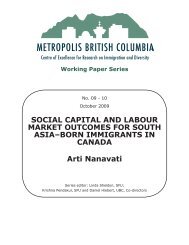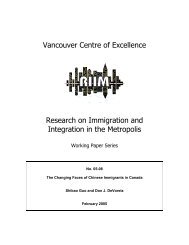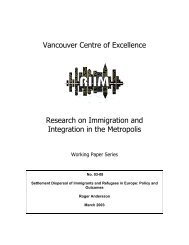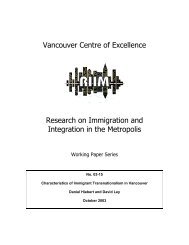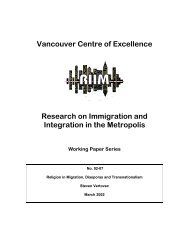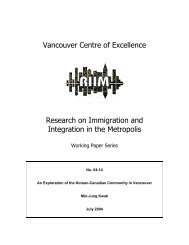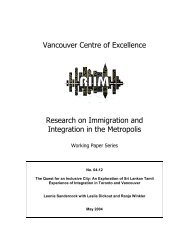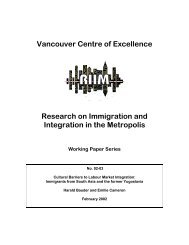Modernization and Global Restructuring of Women's Work
Modernization and Global Restructuring of Women's Work
Modernization and Global Restructuring of Women's Work
Create successful ePaper yourself
Turn your PDF publications into a flip-book with our unique Google optimized e-Paper software.
15<br />
This forced unveiling inflicted pain <strong>and</strong> terror upon those women who were not<br />
willing or ready to unveil. To them, the veil was a source <strong>of</strong> respect, virtue,<br />
protection <strong>and</strong> pride. It was a symbol <strong>of</strong> passage from childhood to adulthood… They<br />
sought to undermine its banishment with all the ingenuity they could muster, (ibid:<br />
35).<br />
The above examples reveal a subtext to “The world my mother gave me.” Let us for a<br />
moment consider Afshane Najmabadi’s (1998) insights. This Iranian scholar suggests that the project<br />
to educate women – an uneven project in terms <strong>of</strong> the sharp urban/rural divide - formed part <strong>of</strong> the<br />
state agenda <strong>of</strong> building the nation. Women’s education was promoted for two reasons: they would<br />
raise disciplined male citizens <strong>and</strong> in addition educated (“unveiled”) women would help to subvert<br />
the western colonial narrative. The driving impulse for the former is: “from educated women would<br />
arise a whole educated nation,” (ibid: 102). The contours <strong>of</strong> the latter are as follows.<br />
Middle Eastern scholars have argued that the West has created a particular kind <strong>of</strong> discourse<br />
where the East is conceived to be backward, inferior <strong>and</strong> frozen in time; the power <strong>of</strong> this discourse<br />
has gained momentum because <strong>of</strong> its entrenchment in institutions that continually construct the East<br />
as the Other. The colonial narrative has always been gendered <strong>and</strong> hence the image <strong>of</strong> women is<br />
deployed to further show the backwardness <strong>of</strong> the East following the erroneous argument: Eastern<br />
societies are oppressive to women <strong>and</strong> therefore they are barbaric; omitted is the fact that women in<br />
the West may not be more liberated <strong>and</strong> may continue to occupy subordinate positions despite<br />
feminist interventions.<br />
Iranian male reformists such as Ali Shariati (1971 cf. Nazmabadi 1998) undertook the task to<br />
counter Western discourse on Orientalism. Invoking the figure <strong>of</strong> Fatima (the daughter <strong>of</strong> the Prophet<br />
Mohammed), he attempted to address two issues: to counter the “westoxicated” image <strong>of</strong> women that<br />
the Shah had promoted as an antidote to the West’s perception <strong>of</strong> the East as backward <strong>and</strong> to resolve<br />
the “problem <strong>of</strong> how women could enter modernity <strong>and</strong> remake themselves as neither western nor<br />
traditional” (Sullivan 1998:217).<br />
Shariati advocated women’s liberation for political ends. He advanced the argument that a<br />
woman who is excluded from literacy, education, culture <strong>and</strong> civilization cannot be expected to raise<br />
future generations devoted to the goal <strong>of</strong> nation building. His reconfiguration <strong>of</strong> the image <strong>of</strong> Fatima<br />
is illustrative. To begin with, Shahriati deemphasized Fatima’s traditional image <strong>of</strong> being the<br />
daughter <strong>of</strong> the Prophet Muhammed, the wife <strong>of</strong> Imam Ali <strong>and</strong> the mother <strong>of</strong> Hassan, Husain <strong>and</strong><br />
Zainub (the Shi’a tradition reveres these individuals). The new image <strong>of</strong> Fatima as reflected in the



